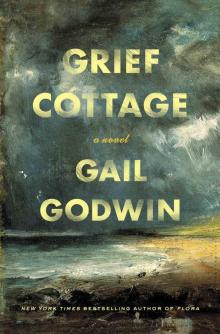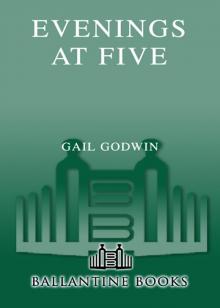- Home
- Gail Godwin
Unfinished Desires
Unfinished Desires Read online
ALSO BY GAIL GODWIN
NOVELS
Queen of the Underworld (2006)
Evenings at Five (2003)
Evensong (1999)
The Good Husband (1994)
Father Melancholy’s Daughter (1991)
A Southern Family (1987)
The Finishing School (1984)
A Mother and Two Daughters (1982)
Violet Clay (1978)
The Odd Woman (1974)
Glass People (1972)
The Perfectionists (1970)
SHORT STORIES
Mr. Bedford and the Muses (1983)
Dream Children (1976)
NONFICTION
The Making of a Writer: Journals, 1961–1963 (2006)
Heart: A Natural History of the Heart-Filled Life (2001)
To Father David Louis Bronson
If you go out walking in our dark wood
When the hawk’s face is tucked beneath his wing
And mist has risen in the hollows
And the owl shrieks:
Do not shrink if on your path
You meet a solitary ghost.
Ask it, “What did you love most?
And what have you left undone?”
Prologue to Suzanne Ravenel’s 1931
school play, The Red Nun
a cognizant original v5 release october 04 2010
Prologue
A MEMOIR BEGUN
May 31, 2001
Feast of the Visitation
House of Olivia and Gudge Beeler
Mountain City, North Carolina
THE ROOM, THOUGH small, is light and airy. A highly polished writing table overlooks a square of lawn with flower borders. On the left side of the table, sharpened pencils have been placed slantwise across a brand-new yellow legal pad. Just behind the pad perches a small brass dinner bell. On the right side of the table is a silver serving tray. Laid out on its starched white cloth are a cut-glass water goblet, a silver pitcher beaded with frost, a tea napkin embroidered with a rose, a package of colored M&M’s, and a designer box of Kleenex tissues.
In the center of the table a shiny ellipsoid tape recorder awaits its mistress.
Two women enter, arm in arm. The stylish one in crisp linen slacks is tactfully leading the old one, who is all but blind. She can still see shapes and colors, identify objects and—with a little assistance from them—the people she knows. Guided by her sense of smell and touch, and from long familiarity with the appropriate things and their happiest placements, she can still recognize a perfectly appointed room.
In her mid-eighties, she has a leonine thatch of crisp white hair, erect posture, and a noble profile. Her glittering blue eyes, set deep in their sockets, make her old girls feel she is seeing into them as keenly as ever, and perhaps she is, aided by other instincts developed and sharpened over her decades of girl-watching. She is dressed with the simple taste of one who prefers tailored over feminine, and the only indication that she is a nun is the Latin cross, pendant on its silver chain, resting on the modest bosom of her silk blouse.
Every spring since the school closed in 1990, a group of her girls have pooled their resources and flown her from the Order’s retirement house in Boston down to Mountain City for a month’s visit. They know how hard it was for her to leave Mountain City, which was home to her for sixty years, first as a seventh-grade boarder from Charleston, South Carolina, then as a boarding student in the academy, from which she took her postulant’s vows in her senior year. From then on, except for semesters away at college after she was professed—and the one awful “leave of absence” (1952–53) enforced on her by her vow of obedience—her entire life as a teaching nun, the headmistress of the academy, and, finally, reverend mother was enacted within the blessed confines of Mount St. Gabriel’s.
This year, she is staying with Olivia Stewart Beeler, class of 1974, possibly her most satisfying class in fifty years of teaching. The ‘74 girls were easy; they were spirited without being spiteful, resourceful without being destructive. Her year with them (as headmistress, she always taught the senior classes) had been a picnic after the stormy sixties and the detritus left in their wake. There had been other rewarding classes, of course, ranging from the bracingly challenging to the sweetly uneventful, as well as the poignant and sad ones, such as ‘43 and ‘44, in which a total of six graduating seniors lost their fiancés in the European or Pacific theaters of war. And those once-in-a-while “star” classes, which kept her intellectually up to the mark, years in which a cluster of girls stood out and shone almost too brightly for the rest of the class’s good, setting off undercurrents of resentment and grief in the less gifted. After that, the postwar daughters of the upwardly mobile, taking for granted their security: even the pranks of those girls were fun-loving rather than mean.
AND THEN, IN the fall of 1951, the poisonous elements convened as the class of ‘55 entered their ninth-grade year and came under her charge. She still calls it the “toxic year” and is uncertain to this day how much of the damage can be laid at her feet.
A year better forgotten. Yet fifty years later she is still haunted by those girls.
But now her old girls have persisted and finally they have prevailed. They have persuaded her that she must write a memoir of the school or, rather, talk it into this waiting machine shaped like a miniature spaceship. “Otherwise, Mother, it will all be lost. Mount St. Gabriel’s was the school of schools. Please. Think about it over the winter. Remember all the assignments you gave us? Well, this is our assignment for you. It will be a fabulous story, Mother. Just start remembering and we’ll do the rest. We have the scrapbooks, the yearbooks, and the press clippings; we’ve even lined up a publisher! But we can’t do it without your memories.”
That was last spring, and she had thought and prayed about it through the long Boston winter—and, if truth be told, had already composed substantial chunks of it in her head. Or, rather, allowed them to compose themselves. Now, this afternoon, in Olivia and Gudge’s beautiful Mountain City home, she is about to begin.
“FIRST OF ALL, Mother, I want you to try this chair and see if it’s comfortable for you at the table.”
The nun traces her fingers lightly across the mahogany curves of the top of the chair. “It’s one of your Chippendales.”
“But this one has arms and a nice plain splat. I didn’t want any ornament digging into your back.”
“You are always so mindful of others, Olivia.”
She settles into the chair. Her hands reach out and explore the shadowy and shiny items on the library table. “And you remembered I’m left-handed!”
“Well, of course, Mother. You made it fashionable for the other southpaws among us. And you always liked to doodle on a pad while you were thinking something out. Now I just want to show you how to operate this recorder. This model is also capable of voice-activated recording, but we needn’t bother about that now. I told Gudge you like to be in charge and would prefer to have the old-fashioned option of starting and stopping on your own terms. But please remember, this is your vacation. Just do a little bit every day.”
“And what do you call ‘a little bit,’ Olivia?”
“Well, a tape has sixty minutes on each side. When the tape cuts off, you might want to call it a day. But if you feel you really have to go on, just tinkle your bell and Sally or I will come and turn it over for you. Oh, and this little grille thing that runs along the front? That’s the microphone. They told us that the sound quality of this model is so superior you won’t even need to raise your voice. Just speak in your normal tone, like there’s maybe one person across the table from you.”
“That person had better be God,” remarks the nun with her characteristic wryness, making Olivia
laugh.
WHEN SHE IS alone, she centers herself in the sturdy Chippendale chair, resting her elbows lightly on its slender curving arms. She takes a deep breath, hears herself exhale. Her nostrils pick up lemon-scented furniture oil, the aftertraces of Olivia’s Chanel No. 5, and the pineapple upside-down cake Sally is baking for her in the kitchen. Through the open windows, the lawn is a slab of chartreuse stamped with shadows, the flower border a blur of pastels with splotches of red and yellow.
Amazingly, she is experiencing the same uneasy flutter from her student days when the monitors at Mount St. Gabriel’s were about to hand out the exam questions and she felt all her careful preparations draining through the holes of her mind.
She leans forward and clasps her hands on the table, then lays them flat, palms down, pleased with their shape and smoothness—they have held up well. Then she rotates the silver band on her left wedding finger. She has long since celebrated her Golden Jubilee—a gala affair at the basilica in Mountain City, covered by the newspapers, the bishop giving the homily “on service” and her old girls coming from as far away as Paris and Venezuela. Her seventy-fifth year as a nun, her Diamond Jubilee, is only eight years away. Will she make it? The age of ninety-three is only beginning to be ancient, these days. As long as she can keep her wits.
She prepares to say a prayer before starting, then decides that the spoken prayer should inaugurate the tape and presses the Record button. There’s a discreet click, followed by a barely audible sibilance—a far cry from the rattletrap machine she practiced on all last winter in Boston.
“Let the words of my mouth and the meditation of my heart be acceptable in Thy sight, O Lord, my strength, and my Redeemer.”
She stops, rewinds, and plays herself back. After all those years in the western North Carolina mountains, she has kept the lowland Charleston drawl of her childhood. People have told her it’s charming, “aristocratic,” but there’s something undeniably frivolous about it, too, especially when reciting a prayer. Did Teresa of Ávila sound frivolous when praying aloud in her aristocratic Spanish?
She knows she can rewind again and record something else over it. But she decides to leave the prayer and continue. In the published memoir, you won’t hear the Charleston drawl.
Lord, what if I am not up to this task? The girls so much want this little history. And who is better equipped than I to do it? I was at Mount St. Gabriel’s the longest of anybody, first as student then teacher. I am the only living person who actually knew our foundress, Mother Elizabeth Wallingford, during her last days in the infirmary. For better or for worse, I am the walking deposit box of what’s left. In every way, I am the most qualified person alive to preserve the memory of Mount St. Gabriel’s, if it is meant to be preserved. And, besides: I want to do it.
Well, Suzanne, as usual you have answered your own question.
But I need to know if you’re with me in this undertaking, Lord. Is it Your will, or am I just being driven by ambition?
For the most part, your ambition has served us well. It has produced many good results, but it has chipped away some of your soul.
(“WHEN YOU SAY you hear ‘His’ side of the dialogue,” her retreat master, Father Krafft, had queried her, “does the voice seem to be speaking to you from the outside? Would you say it is a corporeal audition? That is, do you hear it in the same way you are hearing my voice?”
She was on her month-long retreat before taking final vows.
“No, Father, it’s not outside me, but it’s a perfectly articulate voice and it’s not my voice.”
“What do you mean it’s not your voice?”
“Well, first of all, the pitch is lower. It’s a man’s voice. And He doesn’t have my accent. And it’s wise. He comes up with things I wouldn’t have thought of.”
“Can you be more specific, Sister?”
“He has answers to things I couldn’t begin to solve for myself. He points out places in me I didn’t know existed. It’s not always pleasant, either, Father. He can chastise or diminish. At other times He’s droll, almost teasing. His sense of humor is more the masculine sort.”)
…
I’M NOT SURE I’m following you, Lord, when You say my ambition has produced good results, yet chipped away my soul. If only I could see a plan of this little history I am going to dictate!
Just go tape by tape, Suzanne. Your ambition and your habits of discipline will serve you well. As for the undictated part that is going to restore your soul, remember your Ignatian exercises. Visualize the story of the year that haunts you. Go scene by scene. Inhabit each participant with all your faculties.
This afternoon I am beginning the school history of Mount St. Gabriel’s in Mountain City, North Carolina. This is a great undertaking, but I will do the best I can. There are scrapbooks covering the years from the school’s opening in 1910 to its closing in 1990, and we have yearbooks for all the years except for the first three years of the Great Depression, when the school couldn’t afford them. No girl was sent home because her family could no longer pay board or tuition. We ate a lot of oatmeal and beans in those years, but every girl was fed.
I came to Mount St. Gabriel’s as a seventh-grade boarder in 1929 and was kept on at the school when my father lost everything. That was just nineteen years from the school’s beginning. And I was to remain until its closing. So I was part of very much that happened in that unique place, and with the help of Our Gracious Lord I hope to make this account as interesting as the story of Mount St. Gabriel’s.
—from the preface to Mount St. Gabriel’s Remembered: A Historical Memoir, by Mother Suzanne Ravenel, Order of St. Scholastica, 2006; published by Mountain City Printing Company
PART ONE
CHAPTER 1
Tour of the Grounds
Third Saturday in August 1951
Mount St. Gabriel’s
Mountain City, North Carolina
“WHEN YOU’VE DONE as much girl-watching as I have, Mother Malloy, you can see even as they’re coming up through the lower grades how each class reveals itself as an organism in its own right. You’re not too tired for a bit of a ramble, I hope.”
“Not at all, Mother Ravenel. I’ve only been sitting on trains for two days.”
“Good, in that case”—the headmistress, as quick of step as she was in speech, veered suddenly off the gravel walk and, snatching up her ankle-length skirts, plunged down a woodland path—“we’ll take a turn around the new athletic field and then go up to the grotto and sit with the Red Nun awhile and have a little prayer to Our Lady in front of our Della Robbia.”
“Who is the Red Nun?”
Without slowing her pace, the headmistress turned back to reward the new young teacher with an appreciative smile.
“You know, I often still catch myself thinking of her as a ‘who.’ After all these years! The shortest way to put it is, she’s our mascot. If you can rightly call a six-foot-high ton of red marble a mascot. She’s been unfinished since the middle of the First World War. It’s quite a story, and you know what? I’m going to save it until we’re at the grotto. There are so many things I want to point out to you first. Now, where was I?”
“You were saying about—organisms?”
“Oh, yes. A class is never just a collection of individual girls, though it is certainly that, too, when you’re considering one girl at a time. But a class as a whole develops a group consciousness. It’s an organic unit, with its own special properties. While we’re having our walk, I will tell you a little about your ninth-grade girls, the upcoming freshman class. They are a challenging group, those girls. They will require control.”
“As a—an organism, you mean? Or—some ones in particular?”
“Both, Mother Malloy.”
In the presence of the headmistress, Mother Malloy, who was by habit cool and exact in speech, found herself stumbling and blurting. From my responses so far, she thought, this voluble, assured woman must be wondering how I am going to take charge of a
ny class, not to mention a “challenging” one that requires “control.” Mother Malloy was vexed by the clumsiness that had come over her even as she had been descending the steps of the train, taking caution with her long skirts, thanking the conductor who steadied her by the elbow, when a nun wearing aviator’s sunglasses shot forward to claim her. Mother Ravenel was a vigorously handsome woman of medium height, with a high-colored face and fine white teeth. Snappy phrases, bathed in southern drawl, assailed the young nun from Boston. Her hand was clapped firmly between Mother Ravenel’s immaculately gloved ones and she was mortified that she had not remembered to put on her own gloves.
There was worse to come. Mother Ravenel introduced her uniformed Negro driver and a lighter-skinned young man: “This is Jovan—we call him our Angel of Transportation—and this is his grandson Mark, who will be going off to college next year.”
Mother Malloy extended her hand first to gray-haired Jovan, who took it after the merest hesitation. Though sensing she had done something outside of protocol, she had no choice but to repeat the gesture to young Mark, who, after a quick glance at his grandfather, shook her hand and bolted away to see to her trunk. While the two men loaded it into the back of the wood-paneled station wagon bearing the Mount St. Gabriel’s crest (the archangel with upturned palms floating protectively above mountain ranges), Mother Ravenel tipped her veiled head close to the new nun’s and gently confided, “We do things a little differently down here, Mother, but you’ll get used to our ways. I think you’ll find there’s a great regard between the races and just as much love—if not actually more.”
I have never seen a nun wearing sunglasses, Mother Malloy thought at the train station, trying to contain her mortification and offer it up.
“Of course, girls in their early teens are always difficult,” Mother Ravenel was saying now. She zigzagged off the woodland path and into a clearing. “Do you have sisters, Mother?”

 The Making of a Writer
The Making of a Writer The Making of a Writer, Volume 2
The Making of a Writer, Volume 2 Old Lovegood Girls
Old Lovegood Girls Flora
Flora Publishing
Publishing The Finishing School
The Finishing School Grief Cottage
Grief Cottage Evenings at Five
Evenings at Five Unfinished Desires
Unfinished Desires